Turkey’s Top 12 Archaeological Sites
Turkey Has A Lot To Offer. These You Won’t Want to Miss.

Turkey is one of the most exciting countries on earth for any lover of the ancient world. Its every corner is saturated with history. You can visit Urartu in the far east, then squint at the Hittite inscriptions at Carchemish on the border with Syria. The temple of Augustus at Ankara gives us his Res Gestae. St. Paul hailed from Tarsus. One of the mounds outside Gordium might be the tomb of King Midas.
But some of Turkey’s hundreds of archaeological sites offer particularly remarkable experiences. We couldn’t quite narrow it down to ten, so we offer our top twelve archaeological sites in Turkey.
12. Troy (Truva)
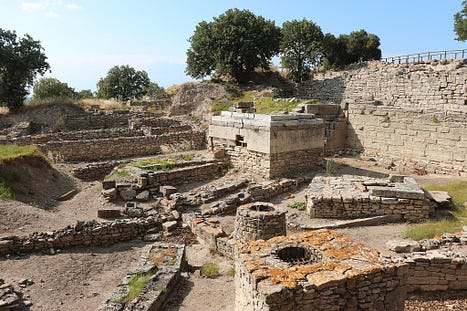 Troy. (source)
Troy. (source)
We confess: there’s not that much to see at Troy. The ruins are so meager that the managers of the site have constructed a big wooden horse that makes the place look like a very rich kid’s treehouse. But — it’s Troy. It’s your chance to see the Scaean Gate and the foundations of “the topmost tow’rs of Ilium.” The smallness of the place is worth seeing all by itself — it’s a lesson of sorts, to see how poetry has magnified what was originally quite small. And while there’s not much to see, the imagination can run wild here like nowhere else. The archaeological site is surrounded by fields and country paths. No one seems to mind if you set off on foot and walk down to the sea (though since the coastline has moved, it is now a good five or six miles’ walk). I skipped a few stones down at the beach in honor of the glories of peace and long life before making my way back to my hotel.
11. Didyma (Didim)
Along with Priene and Miletus, Didyma is one of a trio of remarkable tourist sites south of Kusadasi (Kushadasi). Unlike the other two, Didyma is important really because of a single building: the remains of the Ionic temple of Apollo. Known also as Branchidae for the family that kept the temple, it appears repeatedly in Herodotus’s account of the Persian Wars. As we have written before, there really is no place on earth you can get a better sense of the majesty and magnificence of the Ionic style. The Doric Style of architecture is stout and stony — and for that reason, the best-preserved Greek temples are almost all Doric. The Ionic style was bigger, loftier, grander. Massive drums of gorgeous marble columns lie scattered about the ancient site. It’s one of those places in Turkey you’re likely to have all to yourself too.
10. Sardis
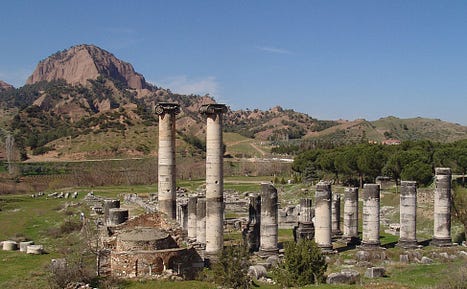
Sardis was the place where Greece and Persia met. The great Royal Road of the Persian Empire arrived — after a journey that Herodotus says would take a walker three months — at the edge of the Mediterranean here. During the Ionian revolt that set in motion the Persian Wars, Sardis was burnt by a group of Greeks that included an Athenian contingent. Later Seleucid satraps and Roman proconsuls alike made this city their center of government. The archaeological excavations include somewhat aggressive reconstructions, though they do show off the opulent swagger of Hellenistic Asia Minor. Exquisite mosaics abound. But perhaps the most remarkable thing is coming inland to Sardis after long journeys along the coast: here you feel for the first time that you have come to a different country, an interior land of open vistas, brown hills, and fertile floodplains. Today we might call it the first outpost of Anatolia; in antiquity it was known as Lydia. A great rock outcrop lords it over the ancient city, which probably looked precisely the same even before there was a Sardis. Just outside town are numerous tumuli, presumed to be the burial-places of Lydian kings, such as Gyges and Croesus and Alyattes. The largest of the tumuli — the Karniyarik Tepe, whose original tenant remains unknown — has a circumference as great as the Great Pyramid.
9. Priene
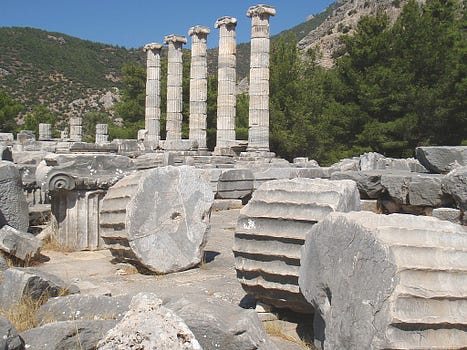
Priene today is a city that makes no sense. Far inland, at the edge of a vast fertile plain, it presses up against the flank of Mount Mycale. What were the Ionian Greeks doing here, and why did they crowd up against a mountain when there was a vast plain to build in? The city, it turns out, was once built on the sea, and the fertile plain was all ocean. The Meander River has brought down enough silt to move the shoreline more than twenty miles out to sea since the city’s founding. The process happened so quickly that even by Hellenistic times Priene was landlocked. The old bouleuterion of the city looks like it was abandoned just yesterday; the archon’s throne appears to be awaiting the results of the most recent election. The ruins here have an inland, forested, bucolic character; they are rarely visited, and offer some of the best atmosphere of all the archaeological sites of Turkey.
8. Miletus

Miletus was one of the great port-cities of Ionia, but like Priene its harbor silted up, and the city was abandoned. Repeated earthquakes through the centuries toppled almost every building, producing the archaeological site we see today, acres upon acres of jumbled broken marble and limestone, and one amazing, indestructible theater. The Milesians were famous for their science and philosophy. Cut off both from the seaborne tourist trade and the larger interior roads, it is now a quiet place: hitchhiking to the site I got picked up by one of the German archaeologists who worked there. Besides the ticket agent at the gate, he was the only person I saw that day in what was once a great and thriving city.
7. Myra
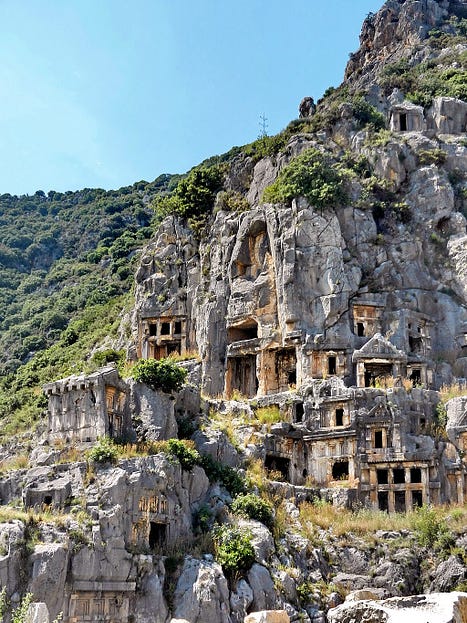
Myra is not a household name, but it’s an incredible site. The star attractions are the Lycian tombs cut into the cliffside. Tourists are not allowed to climb the hill to view them, but they are well worth seeing from down below. Their mere presence, from a culture that accented and ornamented mortality so visibly, feels like a message from a long-gone era. Besides the tombs, there is an impressive Roman theater. Craziest of all, there is a Santa Claus museum here featuring the tomb of Santa Claus. Santa Claus is of course St. Nicholas, who was bishop of Myra. He was buried here. His tomb was raided and his corpse carried off for relics. A visit here to Santa Claus’s cenotaph sounds like a great way to traumatize — or rather, properly educate in real history — your young children.
6. Aspendos
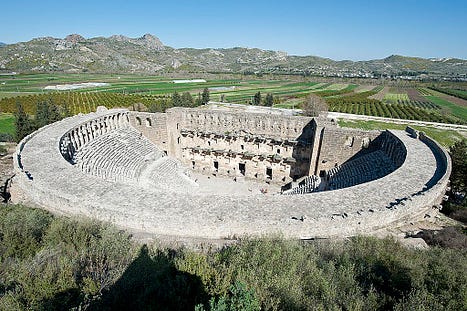
Stone theaters are some of the most remarkable buildings of antiquity. The ancient theater at Aspendos may be the most remarkable of all. In a nearly perfect state of preservation, you can walk through the galleries, enter the cavea, find your seat, and watch plays performed with the full scaena behind the action. It’s almost not an archaeological site at all: it’s just a theater, though it happens to be almost two thousand years old. Around the theater are the remains of the city, generally dilapidated, which makes the theater’s survival even more impressive.
5. Ephesus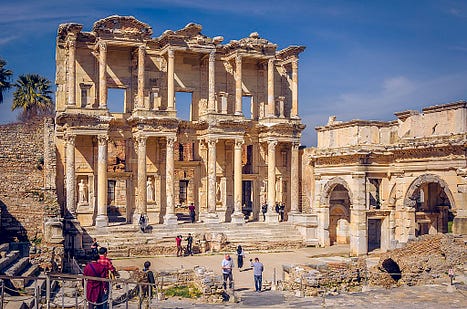
You can argue that Ephesus had been ruined by global tourism. The streets would be packed with tourists in t-shirts complaining about the heat. It does, in fact, get hot at Ephesus, and it’s one of those sites with no shade. But that magnificent stone promenade down to what used to be the harbor — silted up, yet again — and the library of Celsus and the magnificent architecture and that glorious theater — you can see why it brings the tourists in. And now if you can make your way to Turkey we hear the crowds are not nearly so thick as they once were.
4. Pergamum
It is arguable that Pergamum was the grandest city of the Roman Empire; to be sure, no archaeological site can match it for sheer panoramic grandeur. Its acropolis, so vast it needed its own agora (in addition to the agora down in the main city) sits atop a lofty platform of granite, and the watchword everywhere is greatness. The magnificent frieze of the Battle of the Gods and Giants got carted off and installed it in the Pergamonmuseum in Berlin, but you’ll see just how appropriate its original setting once was, high on this Phrygian mountainside. The theater — cut right into the steep hillside, with a view to the setting sun — is one of the world’s most dramatic. And the Library of Alexandria gets all the press, but if we had the Library of Pergamum preserved — with its 200,000 scrolls — we might be just as well off. The site is hot in the summer, and there is little shade, but if you can find a cooler time to visit, there is much to explore — its vast expanse is reminiscent of Hadrian’s Villa.
3. Hierapolis (Pamukkale)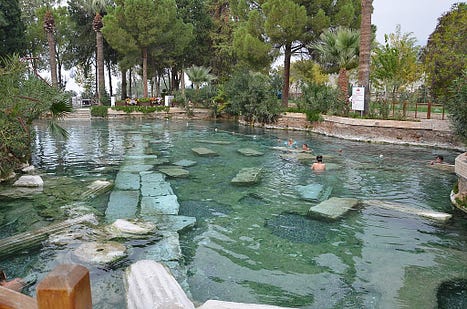
Ancient Hierapolis generally goes by its modern name of Pamukkale (“Cotton castle” in Turkish). For millennia people have come here to visit the hot springs. The mineral-rich water bubbling out of the ground and evaporating in pools has created a series of brilliant white travertine terraces. They’re worth seeing by themselves; but then add in an absolutely spectacular archaeological site adjacent to them and you have something special. There’s a theater, an interesting necropolis, and some fine old buildings. There’s even a pool where you can swim among the ruins (for an extra fee). The “gate of Pluto,” a cave which emits toxic vapors, was recently rediscovered in the area as well. The main drawback is the tourist traffic the area receives, though that has been reduced in the past few years.
2. Aphrodisias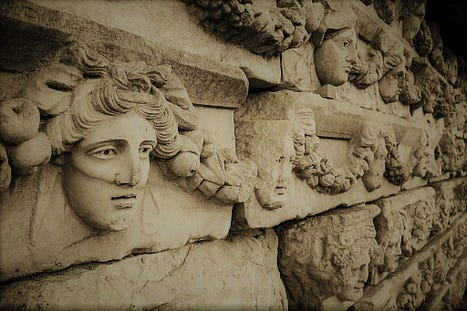 The amazing sculptures of Aphrodisias.
The amazing sculptures of Aphrodisias.Aphrodisias was one of the major artistic centers of the ancient Mediterranean. Local quarries produced superior, warm-tinted marble, and a sculpture industry grew up around it, exporting to every corner of the Roman Empire. Today, exquisite works of art lie mouldering on the ground in every corner of this incredible site. It’s not so much an archaeological zone as it is an outdoor sculpture museum. Well-preserved city walls, a stadium, temples — you name it, Aphrodisias has it — and intricately carved to boot. There’s a trick to visiting Aphrodisias: stay overnight. A remote area of wheatfields and olive groves, there’s not much in the small town of Geyre, a short walk from the ruins, besides a restaurant and two hotels. But this remote site is one to be savored with sketch-book and camera. And if you stay overnight, you can see the ruins by moonlight — an unforgettable experience.
1. Nemrut Dag
Most of Turkey’s best archaeological sites are in Ionia. But the best one of all is in the interior, near the Syrian border. High up in the Taurus mountains, on a 7,000 foot summit, is an ancient sanctuary called Nemrut Dag (pronounced Dah). The work of Antiochus I, a king of the Commagene kingdom (a Roman-era Hellenistic client state), it is presumed the king’s tomb is located here. The mountaintop has been artificially enhanced with a massive tumulus of scree more than 150 feet tall. On twin platforms sit massive (25 feet tall) statues of Antiochus together with an assemblage of gods, facing the rising and setting suns. The statues’ heads have all toppled, making the place look like the set for an “Ozymandias” biopic. The site is remote — it is a trip of more than an hour down a dirt road — and your view is of mountain after mountain stretching into the distance. Tour operators run day trips to Nemrut for reasonable fees from Malatya or Kahta, often including a (jaw-droppingly spectacular) sunrise or sunset. At times it is possible to stay overnight there as well (completely alone), though I can’t imagine that this will continue forever (the place is a UNESCO world heritage site and should be preserved). I came up from Malatya and went down to Kahta the next day. Even in the heat of summer, it is quite cold in the high-altitude desert night, but there are more stars on top of Nemrut Dag than you’ve ever seen before in your whole life, and when the sun rises over the clouds in the morning, you’ll feel like you’ve lived. At any time, though, this is one of the world’s most spectacular places.
Turkey has a lot more than just these twelve sites. In getting to them you will find yourself passing ancient bridges, fragments of old roads, castles crowning hillsides, old walled cities, temples, burial mounds, and just about everything else. Many of them are almost unvisited. Turkey is one of the best countries to rent a car in, as there are so many otherwise inaccessible sites. No matter which ones are your favorites, you can’t go wrong with the twelve we’ve suggested here.
John Byron Kuhner is editor of In Medias Res. He is working on a biography of Reginald Foster, the legendary Vatican Latinist.
Sign up to receive email updates about new articles



Comment
Sign in with